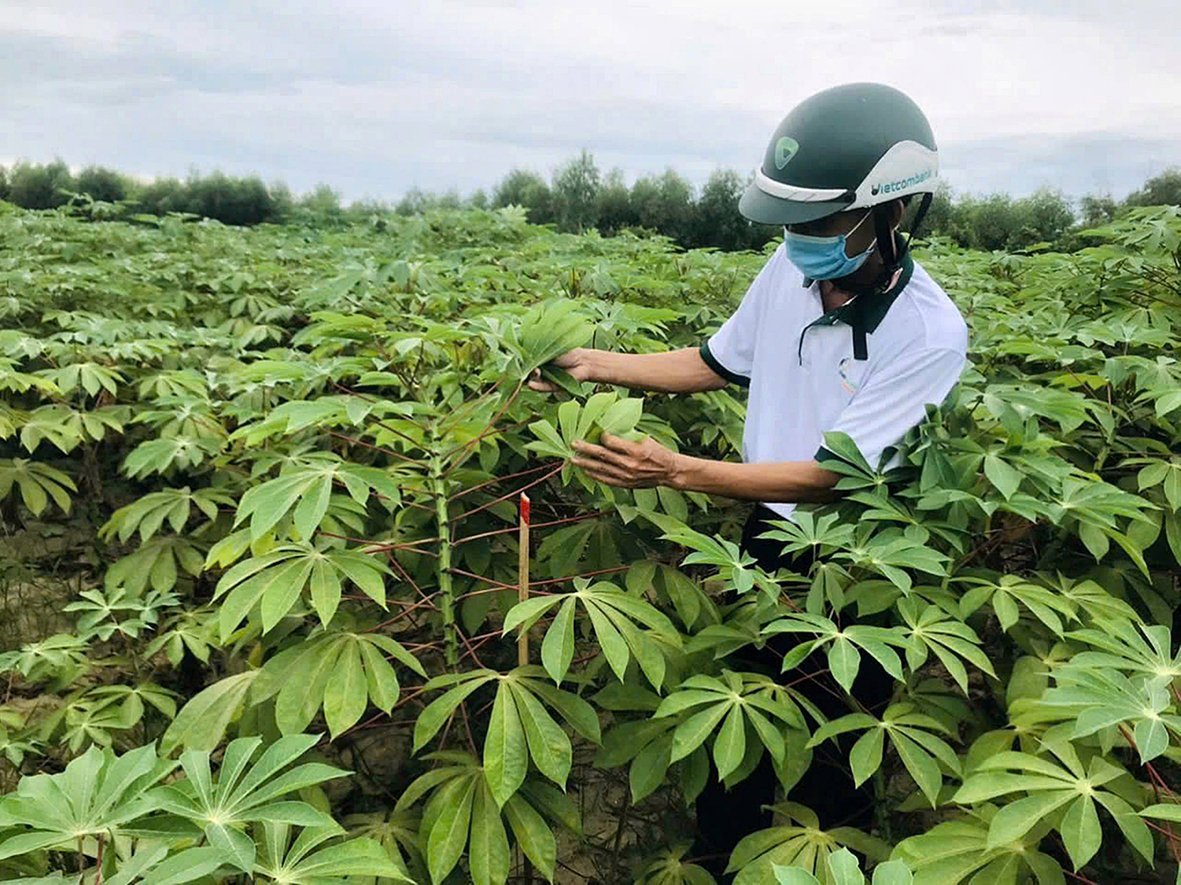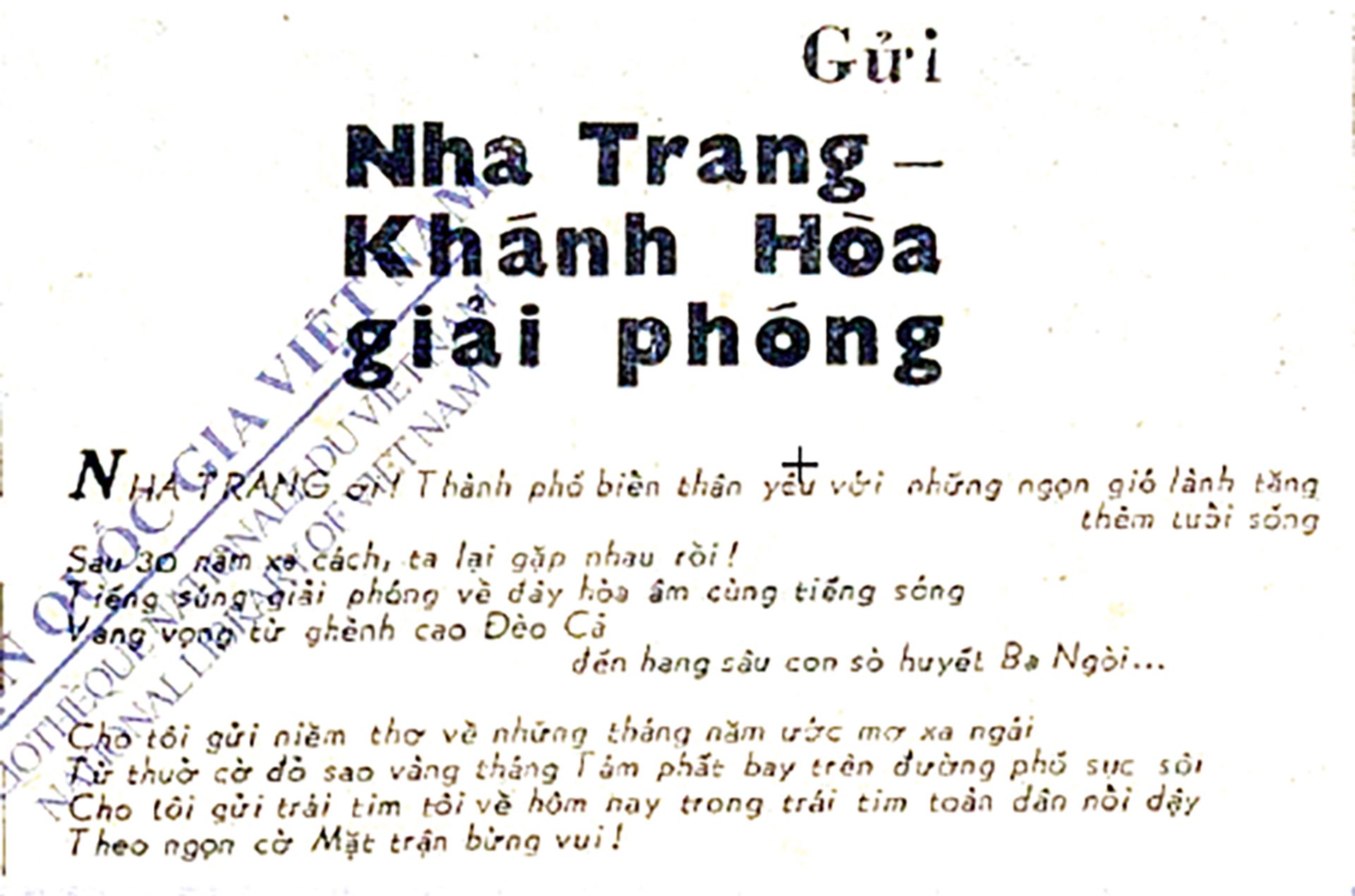Appearing in the province since 2020, cassava mosaic disease is a serious threat, reducing productivity and causing great damage to cassava growers. Therefore, the successful testing of cassava varieties resistant to mosaic disease, especially cassava variety HN1, is expected to produce quality seeds for widespread production.
Checking for signs of mosaic disease infection on experimental cassava varieties - Photo: LA
Deputy Head of the Department of Crop Production and Plant Protection (TT&BVTV) Tran Minh Tuan informed that cassava is a traditional crop, a poverty reduction crop, the main source of income for many farming households in the province, with an annual production area of 11,000 - 12,500 hectares with the main cassava variety being KM94, accounting for 90 - 95% of the area, mainly concentrated in the two districts of Huong Hoa and Dakrong. However, after nearly 30 years of continuous cultivation, the KM94 cassava variety has gradually degenerated, with productivity and quality decreasing, to only about 17 tons/ha.
This cassava variety is also infected with many pests such as pink mealybugs and witches' brooms. In particular, from 2020 to present, the area infected with mosaic virus has been increasing with a total infected area of about 1,118 hectares in 2024. This is one of the serious diseases on cassava, greatly affecting the yield and quality of the product. Infected cassava will reduce the yield by 30 - 55%, greatly affecting the income of cassava growers.
Faced with the complicated developments of the epidemic, on November 30, 2022, the Provincial People's Committee issued Decision No. 3074/QD-UBND approving the project "Testing the resistance to virus-induced mosaic disease and the ability to grow and develop some promising new cassava varieties in Quang Tri province" implemented by the Department of Plant Protection and Disease Control.
The objective of the project is to select 1-2 new cassava varieties that are resistant to viral mosaic disease; have high yield and quality; are adaptable to soil and weather conditions in the province to supplement the cassava variety structure and recommend for mass production, gradually replacing the degenerated KM94 cassava variety infected with viral mosaic disease.
The project was carried out in Vinh Linh, Cam Lo, Huong Hoa districts and Quang Tri town with 6 new promising cassava varieties, recommended by the Ministry of Agriculture and Rural Development, including: HN1, HN3, HN5, STB1, DT4, KM94-1 and the control variety KM94. The implementation area is 2,500 m2/locality. The project implementation period is from 2022 to 2024. The results, through monitoring, showed that the tested cassava varieties all grew well, with a growth period of 10 - 11 months, equivalent to the KM94 cassava variety; suitable for local weather and soil conditions; good lodging resistance.
In particular, the cassava varieties HN1, HN3 and DT4 are more drought-tolerant than the KM94 cassava variety. The average fresh root yield of the tested cassava varieties ranges from 28.7 - 35.8 tons/ha, the highest being the HN1 cassava variety, much higher than the mass-produced KM94 cassava variety. The starch content of the tested cassava varieties is also higher than that of the control cassava variety KM94.
Specifically, cassava varieties HN1, HN5, DT4 have starch content from 30.09 - 33.79%, while cassava variety KM94 has starch content of only about 29%. In terms of economic efficiency, the profit from tested cassava varieties including HN1, HN5, DT4 is 4.5 - 12.7 million VND higher than cassava variety KM94.
Regarding the ability to resist mosaic disease, based on the results of 2 years of continuous testing, it was shown that the cassava varieties HN1, HN3, HN5 were not found to be affected by mosaic disease despite the presence of disease sources and disease vectors in the fields. On the contrary, the cassava varieties STB1, DT4, KM94-1 were all infected with cassava mosaic disease, of which the STB1 variety was the most severely infected with the disease rate of up to nearly 51%.
According to Mr. Tuan, from the results of the project, the HN1 cassava variety was selected as a new cassava variety, ensuring standards such as good growth, high yield, superior starch content, suitable for many types of soil such as red soil, light sandy loam, gravelly soil, especially not infected with mosaic virus to supplement the cassava variety structure of the province, gradually expanding in mass production.
“On this basis, after the project is approved by the Provincial Science Council, the Vietnam Agricultural Genetics Institute and the Department of Crop Production will announce the circulation of the HN1 variety in Quang Tri province. The Plant Protection and Information Department will coordinate with localities and cassava starch processing factories in the province to increase recommendations for the HN1 cassava variety so that people know, put it into production, and gradually replace the KM94 cassava variety that is heavily infected with mosaic disease to improve productivity and economic efficiency,” Mr. Tuan added.
Le An
Source: https://baoquangtri.vn/chon-giong-san-hn1-voi-nhieu-uu-diem-de-thay-the-giong-san-km94-190474.htm




![[Photo] Close-up of Vietnam's sniffer dog team searching for earthquake victims in Myanmar](https://vstatic.vietnam.vn/vietnam/resource/IMAGE/2025/4/1/d4949a0510ba40af93a15359b5450df2)

![[Photo] Prime Minister Pham Minh Chinh meets with King Philippe of Belgium](https://vstatic.vietnam.vn/vietnam/resource/IMAGE/2025/4/1/be2f9ad3b17843b9b8f8dee6f2d227e7)
![[Photo] President Luong Cuong and King Philippe of Belgium visit Thang Long Imperial Citadel](https://vstatic.vietnam.vn/vietnam/resource/IMAGE/2025/4/1/cb080a6652f84a1291edc3d2ee50f631)
![[Photo] General Secretary To Lam receives King Philippe of Belgium](https://vstatic.vietnam.vn/vietnam/resource/IMAGE/2025/4/1/e5963137a0c9428dabb93bdb34b86d7c)






















![[Photo] Myanmar's capital in disarray after the great earthquake](https://vstatic.vietnam.vn/vietnam/resource/IMAGE/2025/4/1/7719e43b61ba40f3ac17f5c3c1f03720)





























































Comment (0)